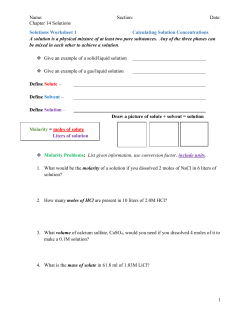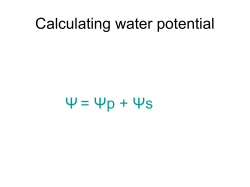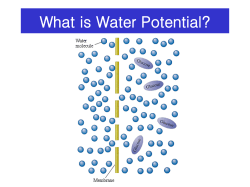
Chemistry Department CHM 1220/1225 Winter 2006 Sample Exam III
Chemistry Department CHM 1220/1225 Winter 2006 Sample Exam III Basic Information The exam will consist of a combination of 5-point and 10-point problems totaling 100 points. You will be given the Clausius-Clapeyron equation, the table of the vapor pressure of water at various temperatures, the table of values of Kf and Kb, and a periodic table. The exam will also provide values for the Ideal Gas Constant, R. Questions 1. A quantity of ice at 0.0ºC was added to 33.6 g of water at 21.0ºC to give water at 0.0ºC. What was the mass of the ice added? The heat of fusion of water is 6.01 kJ/mol; the specific heat of water is 4.184 J/(g•ºC). 2. Methanol, CH3OH, has a normal boiling point of 65.0ºC. It’s heat of vaporization is 37.6 kJ/mol. What is its vapor pressure at 22.0ºC? 3. Predict and explain the order of increasing vapor pressure at a given temperature: CH3CH2CH2CH2OH, HOCH2CH2CH2OH, CH3CH2OCH2CH3 4. Krypton, Kr, has a triple point at –169ºC and 133 mmHg. It’s critical point is at –63ºC and 54 atm. The density 3 3 of the solid is 2.8 g/cm and the density of the liquid is 2.4 g/cm . a. Sketch the phase diagram for krypton, labeling key points. b. What happens to solid Kr at 130 mmHg when the temperature is raised? c. What happens to solid Kr at 760 mmHg when the temperature is raised? 5. A sample of xenon, Xe, has a volume of 5.05 L at 100.ºC and 725 mmHg. What is the volume at 200.ºC and 1222 mmHg? 6. Tin, Sn(s), reacts with hydrochloric acid, HCl(aq), to produce tin(II) chloride, SnCl2(aq), and hydrogen gas, H2(g). 2.40 g Sn reacts with an excess of HCl and the hydrogen produced is collected over water at 27ºC and 712 mmHg.. What would the volume of the dry hydrogen be at 27ºC and 712 mmHg?: Be sure to write a balanced chemical equation and use the data provided on the Information Page. 7. You vaporize a liquid substance at 100.ºC and 755 mmHg. The volume of 0.548 g of vapor is 237 mL. What is the molar mass of the substance? 8. a. What is the ratio of the rate of effusion of He to the rate of effusion of carbon dioxide, CO2? b. What is the rms speed (in km/.hr) of nitrogen, N2, at 298 K (room temperature)? 9. a. What are the five postulates of the Kinetic Molecular Theory? b. Given the van der Waals equation (see Information Page), explain the physical meaning of the variables, “a” and “b”. 10. a. Which of the following would be most soluble in water? CIRCLE ONE: C6H6, O2, CH3CH2OH, CH4, or H2 b. Which of the following would be least soluble in water? CIRCLE ONE: C6H6, O2, CH3CH2OH, CH4, or H2 c. Which of the following would be most soluble in benzene, C6H6? CIRCLE ONE: O2, CH3CH2OH, CH4, or H2 d. Suppose that the solubility of a gas is 3.6 g/100 g water when the partial pressure it 1 atm. What is the solubility of the gas, in g/100 g water, when the pressure is 14 atm? 11. The osmotic pressure of blood at 37ºC is 7.7 atm. Any solution that is given intravenously must have the same osmotic pressure as the blood. What should be the molarity of a glucose solution given intravenously? Would the molarity need to be different if the solution were potassium chloride? 12. Butylated hydroxytoluene (BHT) is used as an antioxidant in processed foods. (It prevents fats and oils from becoming rancid.) A solution of 2.500 g of BHT in 100.0 g of benzene had a freezing point of 4.880ºC. What is the molar mass of BHT? 13. A solution is found to be 0.265 M tartaric acid (H2C4H4O6, a substance used with grapes during wine making). The density of the solution is 1.016 g/mL. What is the molality of the solution? 14. Explain the key dynamics in the dissolving process. Include both factors that favor dissolving and factors that don’t for both molecular and ionic solutes. 15. Multiple Choice A. The pressure exerted on the walls of a container depends on all of the following except a. the average velocity of the molecules b. the temperature of the sample d. the number of atoms per molecule e. the total number of molecules c. the frequency of collisions of molecules with the walls B. Problems with the ideal gas law arise as a. the temperature approaches high values b. the number of moles increases e. the volume expands as pressure decreases c. molecular interactions become significant at low pressure and low volume d. molecular size and interactions become important at high pressure and low temperature C. Which of the following is the best molecular level description of what happens when water, H2O, and ethanol, CH3CH2OH, are mixed? a. a solution forms when the London forces between solute molecules are broken and substituted by London forces that keep solvent molecules together b. a solution forms because the forces that keep solvent molecules together are replaced by solventsolute forces; these forces include hydrogen bonds c. due to the hydrocarbon chain of the alcohol, a solution will not form since attractions between water and alcohol molecules are weaker than attractions between water molecules d. a solution forms due to the large induced-dipole forces that produce a strong attraction between solute and solvent molecules e. due to dipole interactions that keep ethanol molecules together, a solution will not form D. As temperature increases a. the solubility of ionic substances increases b. the solubility of ionic substances decreases c. the solubility of ionic substances increases or decreases depending on the identity of the ionic substance d. the solubility of ionic substances is not affected by temperature E. Osmosis is a. the movement of solvent molecules through a membrane from an area of lower solute concentration to an area of higher solute concentration b. the movement of solute molecules through a membrane from an area of lower solute concentration to an area of higher solute concentration c. the movement of solute molecules through a membrane from an area of higher solute concentration to an area of lower solute concentration d. the movement of solvent molecules through a membrane from an area of higher solute concentration to an area of lower solute concentration F. The Tyndall effect a. is observed in all solutions b. is observed in colloids c. is observed only in selected solutions d. is used to determine the concentration of solutions e. is used to determine the osmotic pressure of solutions Equations and Constants Clausius Clapeyron Equation P2 P1 ln = ΔHvap R 1 1 T1 T2 Values of the molar gas constant, R R = 0.08205783 L•atm/(mol•K) 3 R = 8.314510 kPa•dm /(K•mol) R = 8.314510 J/(K•mol) R =1.987216 cal/(K•mol) Vapor Pressure of Water Temperature 0 10 15 (ºC) Pressure 4.6 9.2 12.8 (mmHg) 27 19 21 23 25 27 30 40 60 80 100 14.5 16.5 18.7 21.1 23.8 26.7 31.8 55.3 149.4 355.1 760.0
© Copyright 2025





















